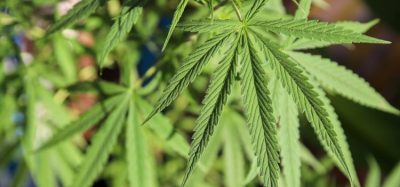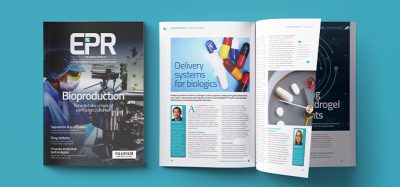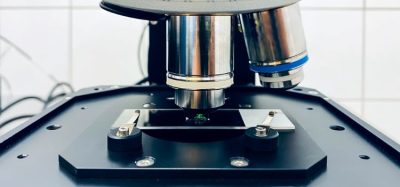The flexibility of regularisation processes for multivariate calibration maintenance
Posted: 5 September 2014 | | No comments yet
In the pharmaceutical industry, it is necessary to control, in a tight range, the active pharmaceutical ingredient (API) content of products, e.g., tablets or other powder blends.


Thus, the API content needs to be continuously monitored. Preferably, analysis for the API content should be in-line (on site) allowing rapid and efficient quality control. It is well documented that spectroscopic methods, such as near-infrared (NIR) and Raman, in conjunction with multivariate calibration processes, can meet these goals under controlled conditions.
The usual mathematical relationship used for multivariate calibration with spectroscopic data is
(1) y = Xb + e
where y denotes an m x 1 vector of quantitative information for the analyte (the API content in this case), m is the number of samples, X symbolises an m x n matrix of spectra measured over n wavelengths, b signifies an n x 1 model vector, and e represents the m x 1 vector of normally distributed errors with mean zero and covariance matrix σ2I with I being the m x m identity matrix13,14. Assuming a good experimental design and outlier removal, the first step in multivariate calibration is to estimate b, by b = X+ y where X+ is a generalized inverse of X. Mathematically, the solution to Eq. 1 can be expressed as determining a b that satisfies the expression min (||Xb – y||22 ) where the double brackets subscripted with 2 denotes the vector L2 norm (2-norm, Euclidian norm) and measures the magnitude (size) of the vector. Once a b is determined, it is then used to predict new samples by y = x b where the superscript T signifies the matrix algebra transpose operation and the hat indicates estimated values. The chemical, physical, instrumental, and environmental conditions captured by X and y and used to form b shall henceforth be referred to as the primary conditions.
If X does not properly span the conditions expected in future production line products to be predicted with the estimated primary calibration model vector b, then predictions of the API content will be in error. Specifically, calibration (reference) samples used to form a multivariate calibration model must span the variations in the chemical, physical, instrumental, and environmental conditions expected in future production line products. This type of global calibration is difficult to accomplish as measurement and sample conditions in the production line will inevitably deviate from those spanned by the original primary calibration samples used is X and y. For example, the current primary calibration can fail due to the calibrated API being lower or higher than the amounts in the calibration y or new spectrally responding chemical constituents appear in X. Depending on the instrument and sample type, other chemical, physical, and environmental influences can cause new spectral features to appear. These include changes in viscosity, particle size, surface texture, pH, temperature, humidity, and pressure. Instrumental effects can also cause a current calibration to fail and these include drift and repairing the instrument with a new source, detector, or other component. Lastly, a calibration model developed on a primary instrument(s) may need to be used to predict the API content from a spectrum measured on a different instrument. Thus, mechanisms are needed to update the primary model to include new chemical, physical, instrumental, and/or environmental effects not in the current calibration domain. If a calibration model is not adapted to new conditions, it will not accurately predict API concentrations (or other calibrated chemical or physical pharmaceutical attributes15,16). For the remainder of this article, any new condition(s) not present in the primary conditions shall be referred to as the secondary condition(s).
An abundance of processes have been presented in order to accomplish calibration maintenance, also referred to as calibration transfer or standardisation17-56. Four fundamental strategies exist. One is the global modeling approach previously described. This process is challenging to realise due to the large number of samples needed to span all potential future conditions and respective API reference values must be determined for each sample. Determining API reference values is time consuming and costly.
As a way to allow global modeling, a second approach to calibration maintenance is to incorporate spectral preprocessing methods such as finite impulse response filters, multiplicative signal correction, derivatives, wavelength selection, mean centering, and orthogonal corrections28,29. The goal of these approaches is to form a model robust to both primary and secondary conditions.
A third approach is adjusting sample spectra measured in new secondary conditions to appear as if measured in the primary condition thereby allowing API content prediction with the primary calibration model. With this strategy, a small set of standardisation (transfer, maintenance) samples are measured in the primary condition at the same time the full calibration set is measured. This small standardization set must be stable and available for measuring in future secondary conditions. However, it is not always possible to measure the same samples in the primary and secondary conditions. Additionally, this process is restricted to situations that modify spectra due to wavelength shifts, intensity changes, and/or baseline offsets and not useable when new sample based variances arise. Recently, an orthogonal adjustment in combination with spectral transformation was developed (dynamic orthogonal projection) that eliminated the requirement of the same samples being measured in the original primary calibration and secondary conditions30.
The fourth strategy, and the emphasis of this article, is to update the primary model. Various approaches exist to accomplish this goal31-52. One process involves augmenting the original calibration set with secondary calibration samples spanning the new spectral variances. In this approach, Eq. 1 is written as (ignoring the e term):
(2) *** Missing equation ***
where M is an s x n matrix of spectra for the s samples measured in the new secondary conditions at the same n wavelengths used to measure the primary samples in X. Reference values for the API content are augmented to y as yM . If the number of secondary samples is large, then essentially a full recalibration is being performed with no gain in efficiency. For example, an efficient approach for API determinations in tablets generated in full production is to first form tablets in a laboratory setting (primary condition) that span some simple tablet variances. The goal is to update this ‘golden’ primary model with just a few new samples measured in the full production secondary conditions. However, if the number of samples is small, then the updated model vector will be biased towards the primary condition due to the majority of the samples spanning the primary condition.
With regularisation processes such as Tikhonov regularisation (TR)40-47 or recursive partial least squares (PLS)48-52 a weighing scheme is used for model updating. For TR, Eq. 2 becomes
(3) *** missing equation ***
where η is a tuning parameter () that provides numerical stability to the inverse operation for solution of b, λ weights the secondary condition samples (), I denotes the identity matrix and 0 is the respective zero vector. Mathematically, solution to Eq. 3 can be expressed as (||Xb – y||22 + η2 ||b||22 +λ2 ||Mb –yM||22). This process has been successfully used with NIR data to model update laboratory prepared tablets to predict API content tablets obtained in a full production44. In other non-pharmaceutical NIR data sets, TR has been effective in updating a primary model formed at one temperature to predict at new temperatures as well as updating a primary model formed on one instrument to predict sample analytes from spectra measured on another instrument40-42. Most recently, TR was used to update a model formed to predict sunflower oil adulteration of extra virgin olive oil samples obtained from one geographic region to predict samples from another geographic region43.
The 0 and ηI terms can be removed from Eq. 3 and the resulting equation could be solved by PLS where λ is now tuned in conjunction with the PLS latent variables (LVs) instead of η. In recursive PLS, the weight tuning parameter λ is put on the primary calibration data and hence, this larger set of samples is down weighted48-52.
Several other TR type processes have been developed and evaluated to accomplish model updating41-43,45-47 including solution to min (||Xb – y||22 + η2 ||b||2 +λ2 ||Mb –yM||22) that uses an L1 (1-norm) causing the updated model to be sparse (wavelengths are selected). These processes provide model updating and wavelength selection simultaneously. A general form of TR type regularisations is satisfying the condition min(||Xb – y||aa + ηb ||Lb – yL||bb +λ2 ||Mb –yM||cc) where a, b, and c are typically set for L1 and/or L2 processes. Two specific variants are in one case with a = b = 2, yL = 0, λ = 0, and L set to a derivative operator to form smoothed regression vectors in the primary conditions and robust to new secondary conditions53. The second TR variation is a modification such that reference samples are no longer needed. Other approaches with no reference samples have been developed, but these processes do not include spectral weighing54-56. The regularisation algorithm with no reference samples satisfies **** MISSING FORMULA *** 45,46. In this expression, ka represents a spectrum of the analyte as a pure component with concentration ya and N symbolizes spectra of samples without the API and hence, the corresponding concentrations of these non-analyte samples are zero. For an API, ya = 1. In the pharmaceutical industry, obtaining samples without the API is not difficult. The flexibility of this TR type approach allows including reference samples, if such samples are available, with N. Thus, it is possible to calibrate and model update with or without reference samples.
The basis of the TR variant with no reference samples assumes a linear Beer-Lambert law type relationship for each measured spectrum x. In this case, x can be expressed as
(4) MISSING FORMULA ***
where yN and KN signify interferent concentrations and respective non-analyte spectra as rows in KN, and r denotes random spectral noise. The non-analyte spectra in KN can be pure component interferent spectra as well as spectra representing instrumental and/or environmental sources affecting x such as scatter, baseline shifts, background, temperature, etc., (all spectral sources for x not due to the analyte). To simplify, spectra in KN are scaled by the respective quantities in yN, and Eq. 4 becomes
(5) MISSING FORMULA ***
where the 1 represents a vector of ones with as many ones as there are spectra in N. Prediction for ya, expressed as, is computed by multiplying x in Eq. 5 by an estimated model vector written as
(6) MISSING FORMULA ***
Based on Eq. 6, three conditions must be satisfied in order to obtain the error-free prediction. These conditions are: 1. MISSING FORMULA , 2. MISSING FORMULA (orthogonality of the model vector to the non-analyte information), and 3. (orthogonality and/or low model complexity). Unfortunately, not all three conditions can be simultaneously satisfied and a compromise is needed to form the final model vector. Identifying model vectors satisfying balances the three conditions.
For the regularisation processes so far described in this article, only one regression vector is estimated. This regression vector (model) is determined such that a trade-off is balanced between modelling the primary and secondary conditions. In other words, the new model vector balances predicting samples from both the primary and secondary condition. Under current study in our laboratory is developing regularisation processes that actually form two model vectors from the primary and secondary data using minimisation expressions similar to those presented in this article.
To date, tablet data for API content have been the most difficult to work with in our laboratory as several factors cause the need to update the primary model. Specifically, principal component analysis of tablets typically reveal that there are batch and tablet effects. In our present work, only one weight is used to update all the secondary conditions represented in M or N. Future work involves using different tuning parameters to separately weight tablet types and batches. This is difficult to accomplish as additional tuning parameters will have to be determined. It is hopeful that advancing regularisations processes allowing two model vectors to be formed will help alleviate this concern.
References
- Hu, Y, Erxleben, A, Ryder, AG, McArdle, P (2010) Quantitative analysis of sulfathiazole polymorphs in ternary mixtures by attenuated total reflectance infrared, near-infrared and Raman spectroscopy, J. Pharm. Biomed. Anal. 2010, 53, 412-420.
- Blanco, M, Villarroya, I (2002) NIR spectroscopy: a rapid-response analytical tool, Trends Anal. Chem. 2002, 21, 240-250.
- Ciurczak, EW, Dremen, J (2010) Pharmaceutical and Medical Applications of Near-Infrared Spectroscopy, CRC Press, Boca Raton, Florida, 2010.
- Menezes, JC, Ferreira, AP, Rodrigues, LO, Brás, LP (2009) Chemometrics role within the PAT context: examples from primary pharmaceutical manufacturing, in: Brown, SD, Tauler, R, Walczak, B (Eds-in-Chief), Comprehensive Chemometrics: Chemical and Biochemical Data Analysis, Elsevier, Amsterdam, The Netherlands, 2009.
- Rodionova, OY, Sokovikov, YV, Pomerantsev, AL (2009) Quality control of packed raw materials in pharmaceutical industry, Anal. Chim. Acta 2009, 642, 222-227.
- Blanco, M, Bautista, M, Alcalá, M (2008) Preparing calibration sets for use in pharmaceutical analysis by NIR spectroscopy, J. Pharm. Sci. 2008, 97, 1236-1245.
- Zheng, Y, Lai, X, Bruun, SW, Ipsen, H, Larsen, JN, Løwenstein, H, Søndergaard, I, Jacobsen, S (2008) Determination of moisture content of lyophilized allergen vaccines by NIR spectroscopy, J. Pharm. Biomed. Anal. 2008, 46, 592-596.
- Roggo, Y, Chalus, P, Maurer, L, Lema-Martinez, C, Edmond, A, Jent, N (2007) A review of near infrared spectroscopy and chemometrics in pharmaceutical technologies, J. Pharm. Biomed. Anal. 2007, 44, 683-700.
- Cogdill, RP, Drennen III, JK (2005) Near infrared spectroscopy in the pharmaceutical industry, NIR News 2005, 23-26.
- Bakeev, KA (2005) Process Analytical Technology: Spectroscopic Tools and Implementation Strategies for the Chemical and Pharmaceutical Industries, Blackwell Publishing, Oxford, 2005.
- Freitas, MP, Sabadin, A, Silva, LM, Giannotti, FM, do Couto, DA, Tonhi, E, Medeiros, RS Coco, GL, Russoand, VFT, Martins, JA (2005) Prediction of drug dissolution profiles from tablets using NIR diffuse reflectance spectroscopy: A rapid and nondestructive method, J. Pharm. Biomed. Anal. 2005, 39, 17-21.
- Dyrby, M, Engelsen, SB, Nørgaard, L, Bruhn, M, Lundsberg-Nielsen, L (2002) Chemometric quantitation of the active substance3 (containing C≡N) pharmaceutical tablet using near-infrared (NIR) transmittance and NIR FT-IR Raman spectra, Appl. Spectrosc. 2002, 56, 579-585.
- Næs, T, Isaksson, T, Fern, T, Davies, T (2002) A User Friendly Guide to Multivariate Calibration and Classification, NIR Publications, Chichester, 2002.
- Kalivas JH (2009) Calibration methodologies, in: Brown, SD, Tauler, R, Walczak, B (Eds-in-Chief), Comprehensive Chemometrics: Chemical and Biochemical Data Analysis, Elsevier, Amsterdam, The Netherlands, 2009, 1–32.
- Xiang, D, Konigsberger, M, Wabuyela, B, Hornung, K, Cheney, J (2009) Development of robust quantitative methods of near-infrared spectroscopy for rapid pharmaceutical determination of content uniformity in complex tablet matrix, Analyst 2009, 134, 1405-1415.
- Igne, B, Talwar, S, Drennen III, JK, Anderson, CA (2011) Improvement if pharmaceutical near infrared calibrations by empirical target distribution optimization, J. Near Infrared Spectrosc. 2011, 19, 1-14.
- T. Fearn, T (2001) Standardization and calibration transfer for near infrared instruments: A review, J. Near Infrared Spectrosc. 2001, 9, 229-244.
- Feudale, RN, Woody, NA, Tan, H, Myles, AJ, Brown, SD, Ferré, J (2002) Transfer of multivariate calibration models: a review. Chemom. Intell. Lab. Syst. 2002, 64, 181-192.
- Cogdill, RP, Anderson, CA, Drennen III, JK (2005) Process analytical technology case study, Part III: Calibration monitoring and transfer, AAPS PharmSciTech 2005, 6, E284-E297.
- Brown, SD (2009) Transfer of multivariate calibration models, in: Brown, SD, Tauler, R, Walczak, B (Eds-in-Chief), Comprehensive Chemometrics: Chemical and Biochemical Data Analysis, Elsevier, Amsterdam, The Netherlands, 2009.
- Cogdill, RP, Herkert, T, Anderson, CA, Drennen III, JK (2007) Synthetic calibration for efficient mentod development: analysis of tablet API concentration by near-infrared spectroscopy, J. Pharm. Innov. 2007, 2, 93-105.
- Du, W, Chen, Z, Zhong, L, Wang, S, Yu, R, Nordon, A, Littlejohn, D, Holden, M (2011) Maintaining the predictive abilities of multivariate calibration models by spectral space transformation, Anal. Chim. Acta 2011, 690, 64-70.
- Shi, Z, Igne, B, Bondi Jr., RW, Drennen III, JK, Anderson, CA (2012) Calibration transfer from pharmaceutical powder mixtures to compacts using prediction augmented classical least squares (PACLS) method, Appl. Spectrosc. 2012, 66, 1075-1081.
- Igne, B, Roger, J, Roussel, S, Bellon-Maurel, V, Hurburgh, CR (2009) Improving the transfer of near infrared prediction models by orthogonal methods, Chemom. Intell. Lab. Syst. 2009, 99, 57-65.
- Wangdong, N, Brown, SD, Man, R (2010) Data fusion in multivariate calibration transfer, Anal. Chim. Acta 2010, 661, 133-142.
- Wangdong, N, Brown, SD, Man, R (2010) Stacked PLS for calibration transfer without standards, J. Chemom. 2010, 25, 130-137.
- DiFoggio, R (2005) Desensitizing models using covariance matrix transforms or counter-balanced distortions, J. Chemom. 2005, 19, 203-215.
- Anderson, CE, Kalivas, JH (1999) Fundamentals of calibration transfer through Procrustes Analysis, Appl. Spectrosc. 1999, 53, 1268-1276.
- Kalivas, JH (2008) Learning from Procrustes analysis to improve multivariate calibration, J. Chemom. 2008, 22, 227-234.
- Zeaiter, M, Roger, JM, Bellon-Maurel, V (2006) Dynamic orthogonal projection. A new method to maintain the on-line robustness of multivariate calibrations. Application to NIR-based monitoring of wine fermentations, Chemom. Intell. Lab. Syst. 2006, 80, 227-235.
- M.O. Westerhaus, Improving repeatability of NIR calibrations across instruments, in: R. Briston, N. Bartiaux-Thill (Eds), Proceedings of the Third International Near Infrared Spectroscopy Conference, Agriculture Research Centre Publishing, Gembloux, Belgium, 1991, pp 671-674.
- Kramer,KE, Small, GW (2007) Blank augmentation protocol for improving the robustness of multivariate calibrations, Appl. Spectrosc. 2007, 61, 497-506.
- Sulub, Y, Small, GW (2007) Spectral simulation methodology for calibration transfer of near-infrared spectra, Appl. Spectrosc. 2007, 61, 406-413.
- Condolfi, A, Massart, DL (2000) Model updating for the identification of NIR spectra from a pharmaceutical excipient, Appl. Spectrosc. 2000, 54, 48-53.
- Riley, MR, Arnold, MA, Murhammer, DW (1998) Matrix-enhanced calibration procedure for multivariate calibration with near-infrared spectra, Appl. Spectrosc. 1998, 52, 1339-1347.
- Wehlburg, CM, Haaland, DM, Melgaard, DK, Martin, LE (2002) New hybrid algorithm for maintaining multivariate quantitative calibrations of a near-infrared spectrometer. Appl. Spectrosc. 2002, 56, 605-614.
- Wehlburg, CM, Haaland, DM, Melgaard, DK (2002) New hybrid for transferring multivariate quantitative calibrations of intra-vendor near-infrared spectrometers. Appl. Spectrosc. 2002, 56, 877-886.
- Stork, CL, Kowalski, BR (1999) Weighting schemes for updating regression models – a theoretical approach. Chemom. Intell. Lab. Syst. 1999, 48, 151-166.
- Capron, X, Walczak, B, de Noord, OE, Massart, DL (2005) Selection and weighting of samples in multivariate regression model updating. Chemom. Intell. Lab. Syst. 2005, 76, 205-214.
- Kalivas, JH, Siano, GS, Andries, E, Goicoechea, HC (2009) Calibration maintenance and transfer using Tikhonov regularisation approaches, Appl. Spectrosc. 2009, 63, 800-809.
- Kunz, MR, Kalivas, JH, Andries, E (2010) Model updating for spectral calibration maintenance and transfer using 1-norm variants of Tikhonov regularisation, Anal. Chem. 2010,89, 3642-3649.
- Kunz, MR, Ottaway, J, Kalivas, JH, Andries, E (2009) Impact of standardization sample designs on Tikhonov regularisation variants for spectroscopic calibration maintenance and transfer, J. Chemom. 2009, 24, 218-229.
- Kunz, MR, Ottaway, J, Kalivas, JH, Georgiou, CA, Mousdis, GA (2011) Updating a synchronous fluorescence spectroscopic virgin olive oil adulteration calibration to a new geographical region, J. Agric. Food Chem. 2011, 59, 1051-1057.
- Farrell, JA, Higgins, K, Kalivas, JH (2012) Updating a near-infrared multivariate calibration model formed with lab-prepared pharmaceutical tablet types to new tablet types in full production, J. Pharm. Biomed. Anal. 2012, 61, 114-121.
- Ottaway, J, Farrell, JA, Kalivas, JH (2013) Spectral multivariate calibration without laboratory prepared or determined reference analyte values, Anal. Chem. 2012, 85, 1509-1516
- Kalivas, JH, Georgiou, CA, Moira, M, Tsafaras, I, Petrakis, E, Mousdis, GA (2014) Food adulteration analysis without laboratory prepared or determined reference food adulterant values, Food Chem. 2014, 148, 289-293.
- Kalivas, JH (2012) Overview of two-norm (L2) and one-norm (L1) Tikhonov regularisation variants for full wavelength or sparse spectral multivariate calibration models or maintenance. J. Chemom. 2012, 26, 218-230.
- Wold, S (1984) Exponentially weighted moving principal components analysis and projections to latent structures, Chemom. Intell. Lab. Syst. 1984, 23, 149-161.
- Helland, K, Berntsen, HA, Borgen, OS, Martens, H (1991) Recursive algorithm for partial least squares. Chemom. Intell. Lab. Syst. 1991, 14, 129-137.
- Dayal, BS, MacGregor, JF (1997) Recursive exponentially weighted PLS and its applications to adaptive control and prediction, J. Proc. Cont. 1997, 7, 169-179.
- Qin, SJ (1998) Recursive PLS algorithms for adaptive modeling, Computers Chem. Engng. 1998, 22, 503-514.
- Wangdong, N, Tan, SK, Ng, WJ, Brown, SD (2012) Localized, adaptive recursive partial least squares regression for dynamic system modeling, Ind. Eng. Chem. Res. 2012, 51, 8025-8039.
- Forrest, S, Kalivas, JH (2006) Tikhonov regularisation in standardized and general form for multivariate calibration with application towards removing unwanted spectral artifacts, J. Chemom. 2006, 20, 22-33.
- Marbach, R (2002) On Wiener filtering and the physics behind statistical modeling, J. Biomed. Optics 2002, 7, 130-147.
- Marbach, R (2005) A new method for multivariate calibration. J.Near Infrared Spectrosc. 2005, 13, 241-254.
- Boulet, JC, Roger, JM (2010) Improvement of direct calibration in spectroscopy, Anal. Chim. Acta 2010, 668, 130-136.
Biography
Dr. John H. Kalivas completed his chemistry doctorate from the University of Washington in 1982 and joined Idaho State University in 1985. He is author or co-author of over 100 papers, book chapters, and books. He serves as Editor for the Journal of Chemometrics and Applied Spectroscopy and on several Editorial Boards.







